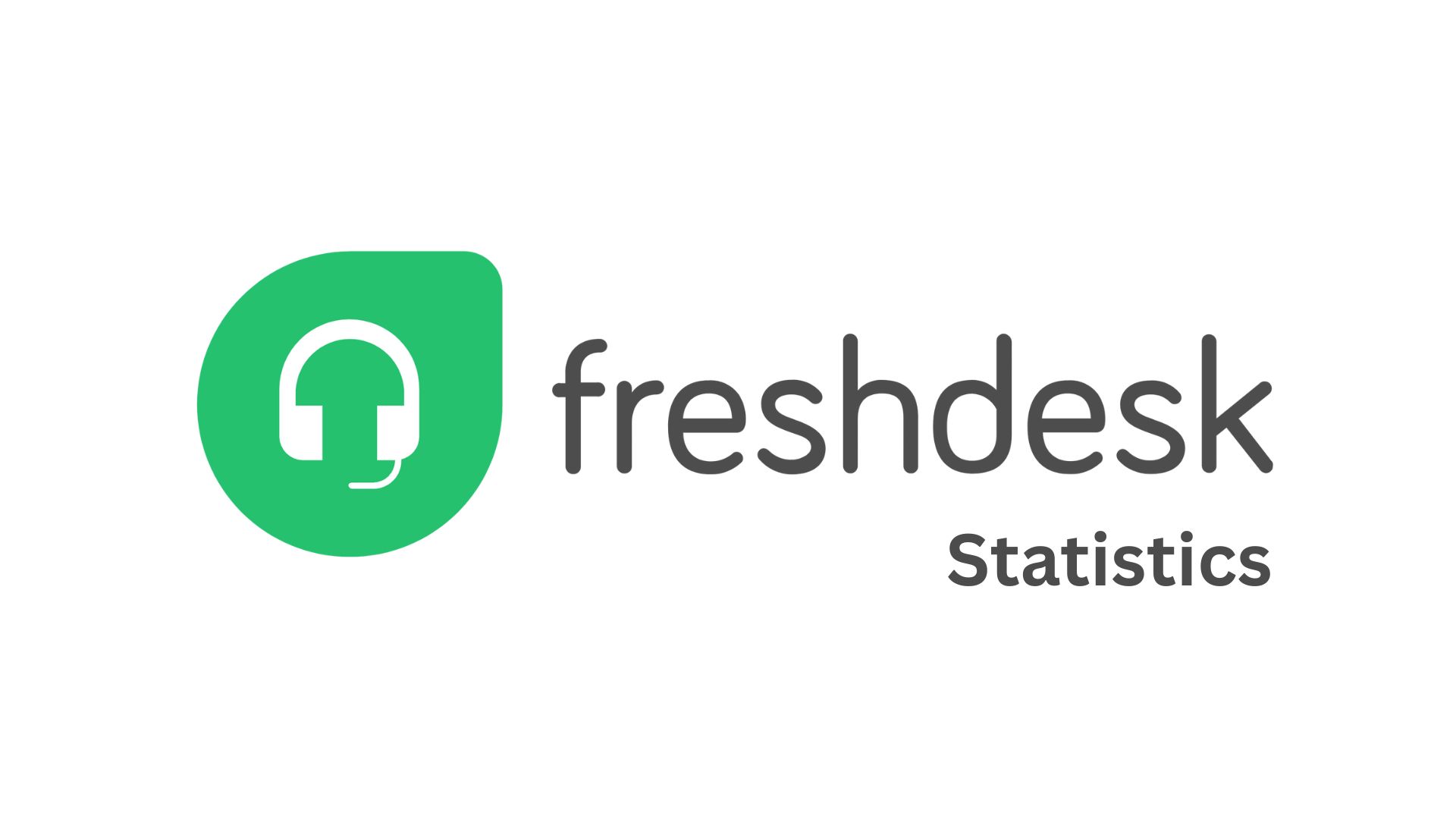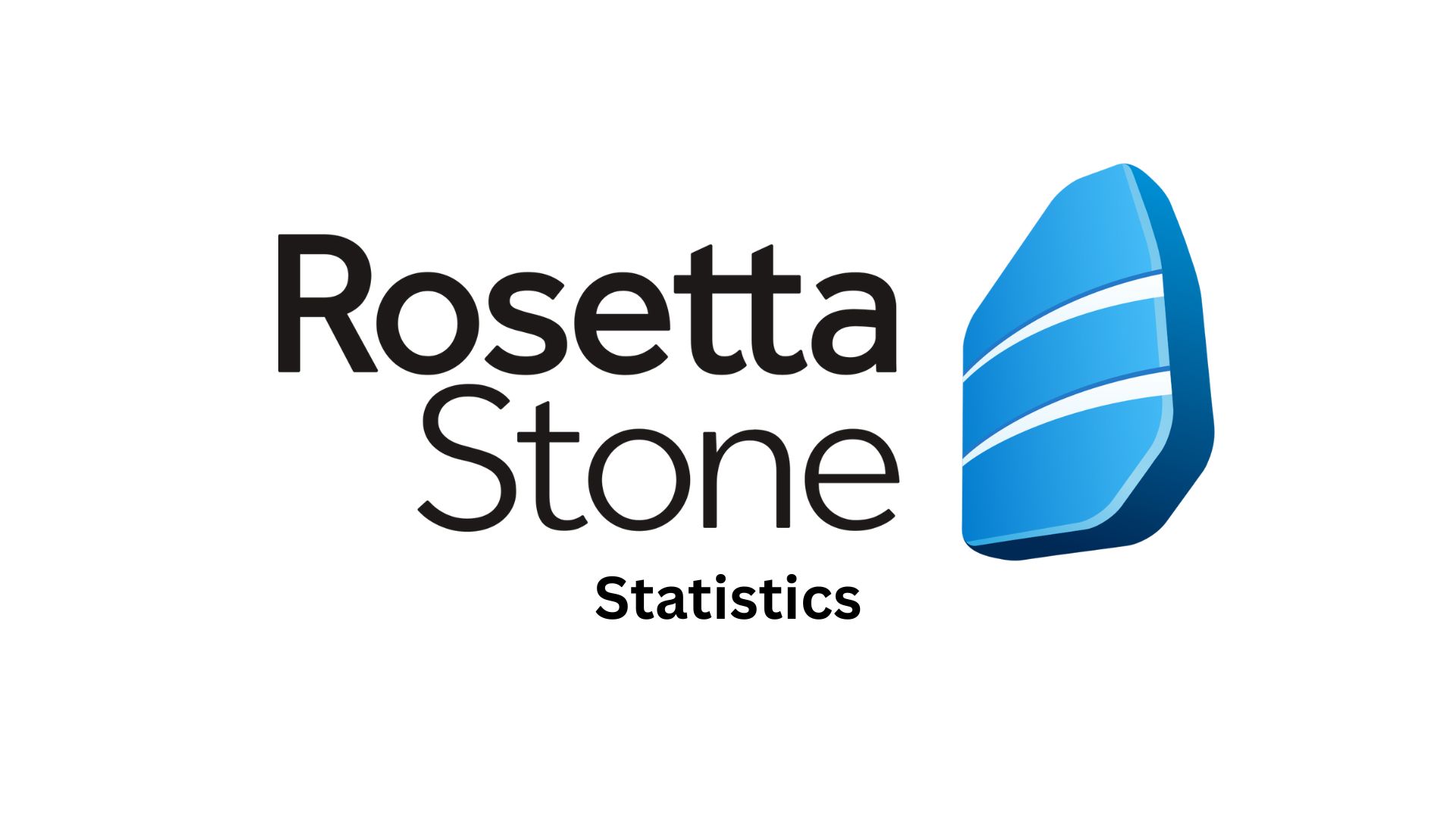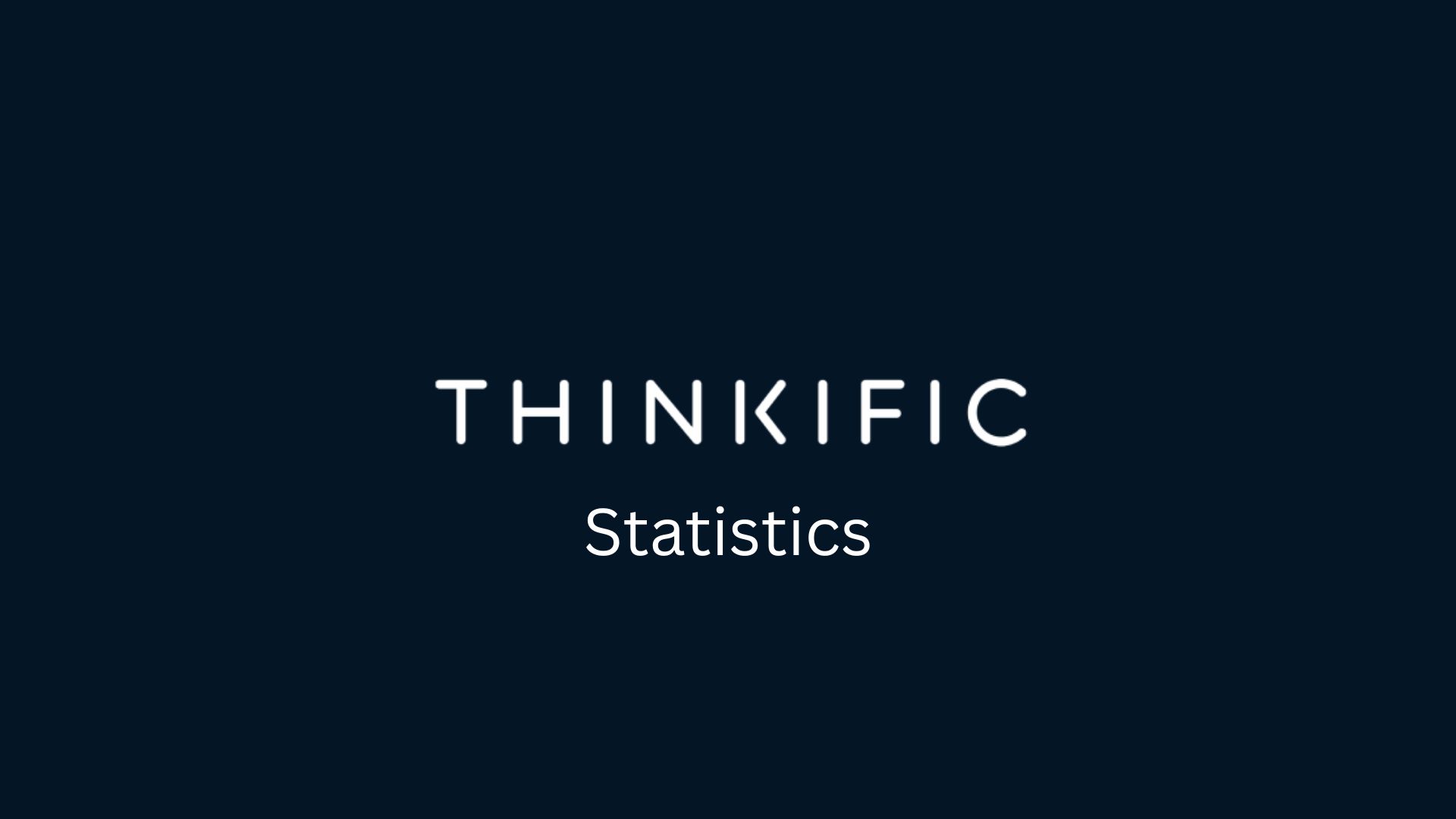Canva Statistics By Revenue, Market Share, Users, Downloads and Facts
Updated · Feb 26, 2025
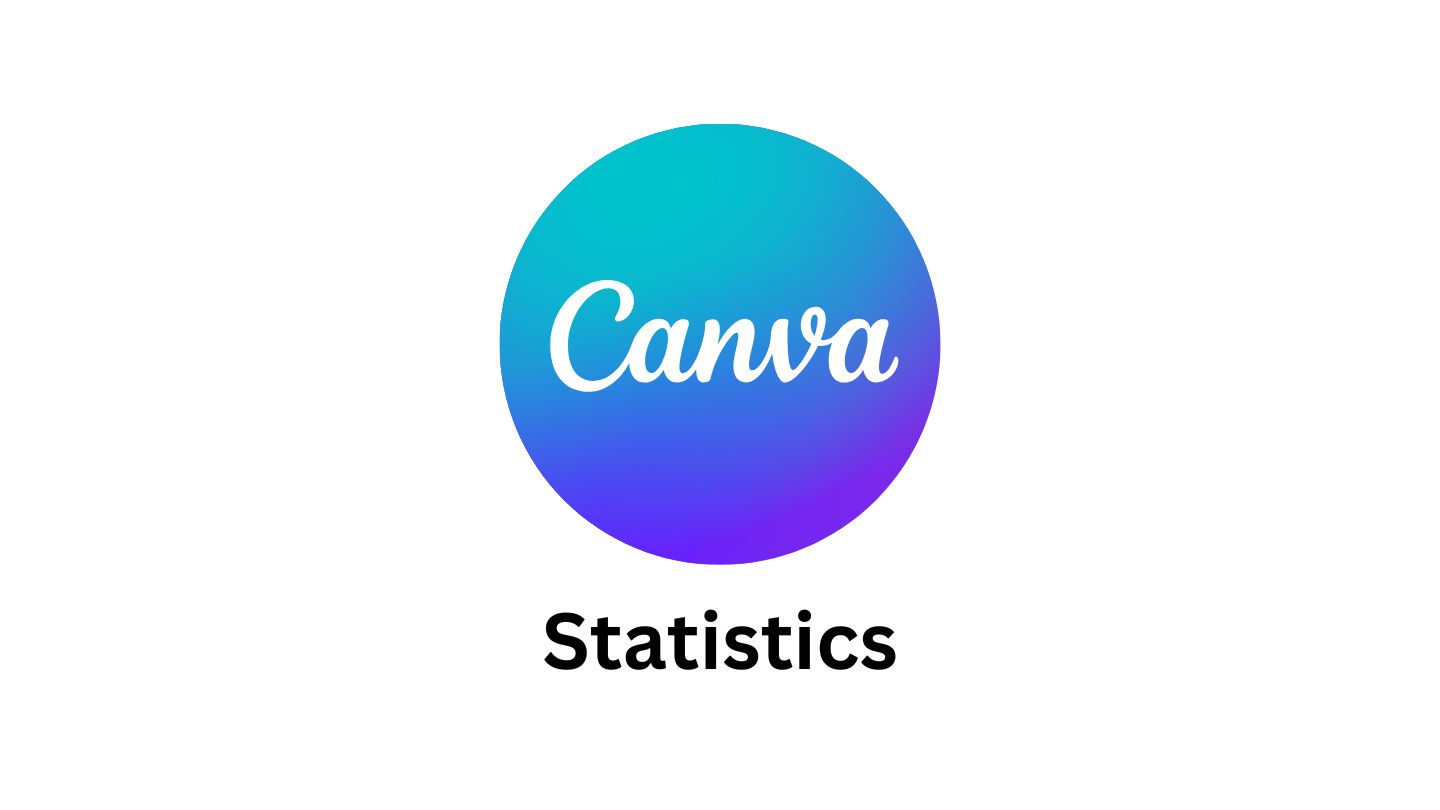
Table of Contents
- Introduction
- Editors Choice
- Market Share of Canva and Other Leading Graphics Software
- Canva Revenue
- Leading Photo Editor Apps By Downloads
- Most Popular Photo and Video Editor Apps By Revenues
- Canva Users
- Canva Valuation
- Canva App Downloads By Country
- Canvas Global Reach, Workforce Growth, and Customer Satisfaction
- Canva Users By Industry
- Canva User Demographics
- Canva Teams Statistics
- Canva Design statistics
- Conclusion
Introduction
Canva Statistics: Canva, which was founded by Melanie Perkins, Cliff Obrecht, and Cameron Adams, is known to be established in the year 2013, and it has changed the sky of graphic designing by making design available to all people, irrespective of the different professions. With an amazing growth trajectory as of 2025, Canva has set itself as a major notch in the design sector.
This article talks more about the interesting Canva statistics, including user growth, money numbers, strategic acquisitions, and AI integration to improve it.
Editors Choice
- According to Canva statistics, Canva had a share of 10.26% in the US$15.4 billion creative software market as of 2024, while Adobe Corporation controlled 70% of it.
- Canva would now occupy a 46% client share compared to Microsoft’s PowerPoint, which has only a 23% market share in presentation software.
- Most users of Canva presentation-based materials belonged to the education (23%) and marketing (20%) sectors.
- From US$4.4 million in 2016 to US$2.7 billion in 2024, means milestones, including US$500 million in 2020 and US$1 billion in 2021.
- Canva, by November 2024, had become the most downloaded photo editing app with 1.16 million downloads in the U.S.
- Canva statistics reveal that the revenue figure for Canva in America in November 2024 was US$8.5 million, making it the leading revenue-generating app in photo and video editing.
- Canva will have 185 million counts of monthly users in 2024 across 190 countries, which is 3700 times more than at the time of its founding.
- Over 16 million users of Canva do it for cash by 2023.
- Canva’s high valuation peaked at US$40 billion in 2021, but it held firm at US$32 billion in 2024.
- The mobile application of Canva has been used 500 million times by people of different countries. India, Indonesia, and Brazil are the main countries contributing the most.
- Website visits made Canva number 45 in the world, and this is with a 13.37% contribution from the U.S. numbers alone in 2024.
- Canva statistics state that by 2024, employee figures at Canva had grown to 5,000 people, representing a 150% increase by 2021 and 1,000% compared to 2013.
- Among employees in 2024, 83% will recommend working for Canva, while CEO Melanie Perkins has an 82% approval rating.
- Canva received 358,000 applications for jobs in 2024, which averages out to more than 1000 a day.
- With an 89% CSAT score, a customer loyalty score of 83%, and an NPS of 59%, customer satisfaction was quite high.
- More than 90% of Fortune 500 companies make use of Canva.
- Canva emerged to be the most favored AI tool for crafting images in the year 2023, with 51% of influencers using it.
- Canva statistics show that Canvas service was used in 2023 by more than 500,000 nonprofits, while 800,000 individuals participated in designs.
- In 2024, 70 million educators and students will be using Canva for Education, unchanged from 2020 but expanded by 700% since then.
- Among Canva users, the largest age group (31%) was individuals aged 25-34, while the second largest (21.77%) was aged 18-24.
- May 2024 saw the launch of Canva Enterprise, with team users for businesses almost doubling to 135,000 in 2023.
- In 2024, 95% of Fortune 500 companies used Canva Teams, a significant upward trend from only 40% in 2015.
- Canva statistics indicate that Canva Teams achieved a 90% reduction in production time, a 50% cost saving on designs, and 30% fewer work hours devoted to external design.
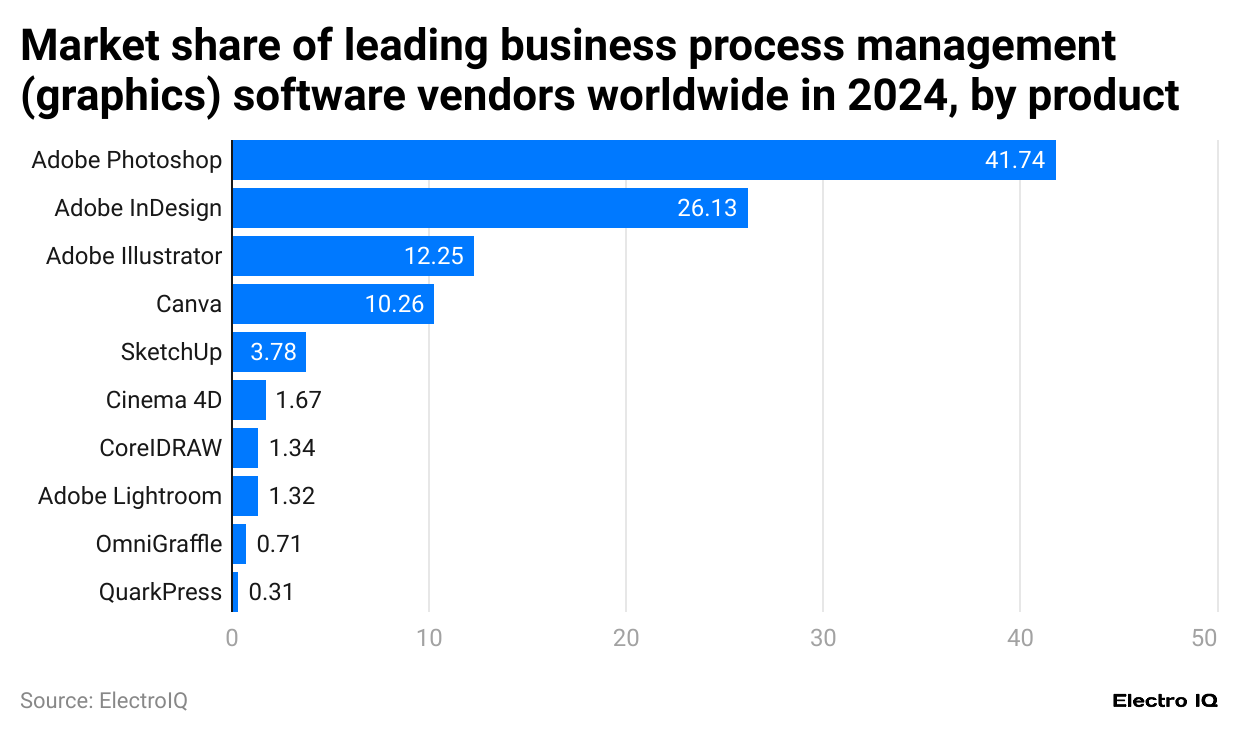
(Reference: statista.com)
- Canva statistics state that in the year 2024, the creative software market was valued at US$15.4 billion, of which 10.26% was accounted for by Canva.
- Adobe was the undisputed leader in the market since it had a 70% market share. Canva fared much better in the presentation software market where it held a 46% share.
- It was up against over 36 other tools in the category, including Microsoft’s PowerPoint which has a 23% share, Scribd with 10%, and Prezi with 5%.
- When it comes to Canvas customers in the presentation market, Education was the largest user group, comprising 23%, followed by Marketing at 20%, with Digital Marketing and Social Media representing 15% and 14%, respectively.
- Geographically, most of the presentation users of Canva were based in the United States, which is made up of 65% of the whole percentage.
- The United Kingdom has 9%, while Canada represents 6%. In Office Productivity software, Canva had a very small share, boasting a meager 0.02% in the category.
- The bulk of customers in this category were from Higher Education (10%), Marketing and Advertising (6%), as well as Nonprofits (6%). With regards to organization size, the highest proportion of users comprises very small businesses (47%), followed by medium-sized companies (31%) and large enterprises (21%) of all organizations using Canva.
Canva Revenue
| Year | Canva’s Revenue | YoY % Growth |
|---|---|---|
| 2016 | $4.4 million | – |
| 2017 | $60 million | 1264% |
| 2018 | $84 million | 40% |
| 2019 | $105 million | 25% |
| 2020 | $500 million | 376% |
| 2021 | $1 billion | 100% |
| 2022 | $1.7 billion | 70% |
| 2023 | $2 billion | 18% |
| 2024 | $2.7 billion | 35% |
(Source: whop.com)
- The revenues of Canva have seen considerable growth since it was established. In 2016, the company registered revenues of US$4.4 million, but in 2017, revenues soared to US$60 million, corresponding to a phenomenal increase of 1,264%.
- In 2018, revenues at Canva continued to grow to US$84 million, marking a 40% increase from the previous year. Growth continued in 2019 to reach US$105 million; this was a 25% increase.
- In 2020, though, the real acceleration was experienced, with revenues enhancing to US$500 million, reflecting an enormous growth of 376%.
- The rapid growth momentum continued into 2021 with an arrival at the mark of US$1 billion in revenues, doubling the previous year’s investments.
- Canva was able to generate revenues of US$1.7 billion in 2022, recording increased revenue by 70%, while in 2023, it garnered another US$2 billion by growing 18%.
- Its revenue reached US$2.7 billion in the financial year 2024, registering a commendable growth of 35%. Over the years, Canva evolved from a small startup to a billion-dollar company, with steady growth in revenues and extensive global outreach.
Leading Photo Editor Apps By Downloads

(Reference: statista.com)
- In terms of downloads, in November 2024, Canva, a well-known photo-editing application, was downloaded over 1.16 million times in the United States from both the Google Play Store and the Apple App Store.
- The application was the most downloaded in its category for that month.
- The next most downloaded app was Remini, developed by Bending Spoons, an Italian company, with 763,000 downloads. Picsart, a Florida company, came in third with almost 702,000 downloads.
- Near the close of 2023 and into 2024, many photo and video editing apps in the U.S. began adding AI features, thereby increasing their level of sophistication and attracting customers.
Most Popular Photo and Video Editor Apps By Revenues
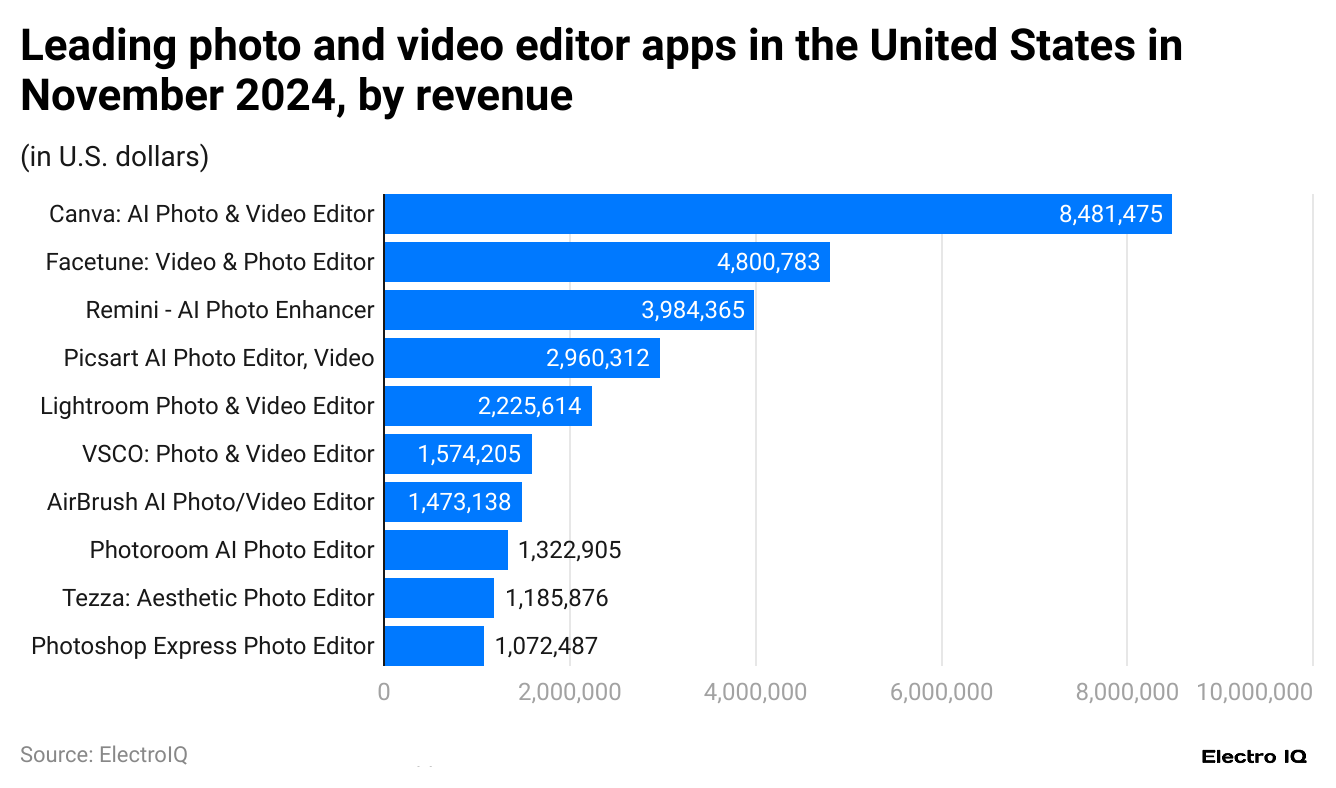
(Reference: statista.com)
- Canva has had revenues of US$8.5 million-plus in November 2024 from mobile editing. It is so popular for easy collage-making and photo content.
- Next was Facetune by Lightricks, earning less than half – US$4.8 million – in revenue that month.
- Selfie filters are the mainstay of Instagram fame for Facetune. Another famous photo editor app, Remini-AI Photo Enhancer, pulled in US$3.9 million from users in the USA.
Canva Users

(Reference: wethrift.com)
- Canva has built a big global community of designers, with over 185 million users of the platform every month across 190-plus countries.
- It provides easy-to-use design tools for individuals and teams, making design accessible to everyone.
- Established in 2013, Canva has witnessed phenomenal growth and has now expanded its user base by 3,700 times from that point.
- When it first started, there was already a waiting list of more than 50,000 eager persons willing to use the platform.
- By its first birthday, Canva had recorded 100,000 users. By 2015, more than 1.5 million people were using Canva every month to create more than 50 million designs. The user increase trend continued in 2016 when the user base increased to 3.6 million and to 24 million users only 3 years later in 2019.
- Therefore, in 2021, Canva reached over 75 million active users in a month; that number increased, reaching 100 million in 2022 and 135 million in 2023, averaging a growth of about 57.14% over three years.
- Today, there are over 185 million Canva users every month, including businesses and teams the world over. By the end of 2023, 16 million users were also paying for premium features on Canva.
Canva Valuation
| Year | Canva’s Valuation |
|---|---|
| 2015 | $165 million |
| 2016 | $456 million |
| 2018 | $1 billion |
| 2019 | $2.5 billion |
| 2020 | $6 billion |
| 2021 | $40 billion |
| 2022 | $39 billion |
| 2023 | $32 billion |
| 2024 | $32 billion |
(Source: whop.com)
- Canva’s valuation has grown astronomically through the years. Back in 2015, it was worth US$165 million. Within a year, in 2016, the company was able to increase its value to an estimated US$456 million, almost three times its 2015 market capitalization.
- By 2018, Canva became a unicorn with a valuation of US$1 billion. The company was still on the rise, climbing to US$2.5 billion in 2019 and further rising to US$6 billion in 2020.
- However, an immense leap for the company happened in 2021, with its valuation soaring to US$40 billion-the biggest milestone yet.
- In 2022, it is said to have dipped to US$39 billion and entered another slump to US$32 billion in 2023.
- Despite this disruption in valuation, it remained at US$32 billion in 2024, signifying that this is still a respected and solid business.
Canva App Downloads By Country
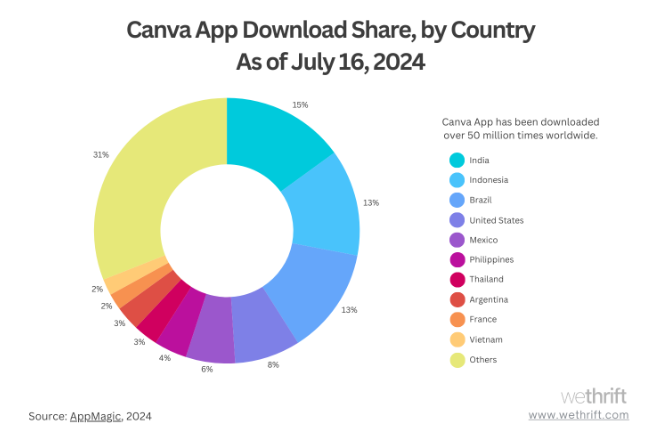
(Source: wethrift.com)
- The Canva application is now a global phenomenon that reaches users in more than 190 countries, meaning it is present in almost 95% of the world. Its mobile app is also a huge hit, boasting over 500 million downloads.
- The biggest markets are India, Indonesia, and Brazil, contributing equally around 15%, 13%, and 13%, respectively, to total downloads-which means more than 50 million downloads for each country. The ratings of the app have been phenomenal.
- It boasts 4.9 on the Apple Store, based on over 2.1 million reviews, and holds a 4.8 score on Google Play, having attracted over 17 million users.
- Then there is much traffic on the website of Canva as well. In the past three months, it has been ranked 45 in the world by web traffic, with 5 being its rank in the category.
- Whereas in the United States, it ranks 98 among all websites. From April to June 2024, the majority of the visitors to the website can be traced mainly to the US; 13.37% of total visits came from there. Brazil was next with 9.03%, India with 5.93%, Indonesia with 4.54%, and Mexico with 4.48%.
- Canva saw a slight dip in total website visits. It recorded about 901.2 million visits in May 2024, which went down by 7.57% to 833 million visits in June.
Canvas Global Reach, Workforce Growth, and Customer Satisfaction
- With 190 countries and more than 100 languages at its disposal, Canva in 2024 achieved its goal of being accessible worldwide. This increase in figures since 2015, when it was available in 179 countries, comes to 6%.
- Canva can thus be said to cover up to 97% of the world. The staff at the company’s headquarters at the close of 2024 boasted a little over 5,000 employees, whom they are referred to as “Canvanauts,” spread across eight countries.
- This translates into wonderful growth amounting to 150% since 2021 when there were 2,000 employees, and the marvellous achievement of over 1,000% since 2013, when Canva started with just five people.
- The growth of Canva over the years is truly remarkable in terms of its staff. The team grew by 900% to 50 employees in 2015, doubled to 100 in 2016 and 500 in the year 2019, while by 2020, there were more than 1,000 employees.
- In 2024, 83% of employees would recommend working at Canva to a friend, and 82% approved of CEO Melanie Perkins. This in great part, explains why, in 2024, Canva received the most job applications in history, receiving over 358,000 applications—over 1,000 applications a day.
- Half of the interviewees had a positive candidate experience, while the customers had a very high level of satisfaction with the Canva service.
- The company achieved a customer satisfaction (CSAT) score of 89%, whereas customer loyalty came in at 83%. In addition, Canva registered a 59% Net Promoter Score (NPS) rating; this means that many users would recommend the platform to others.
Canva Users By Industry
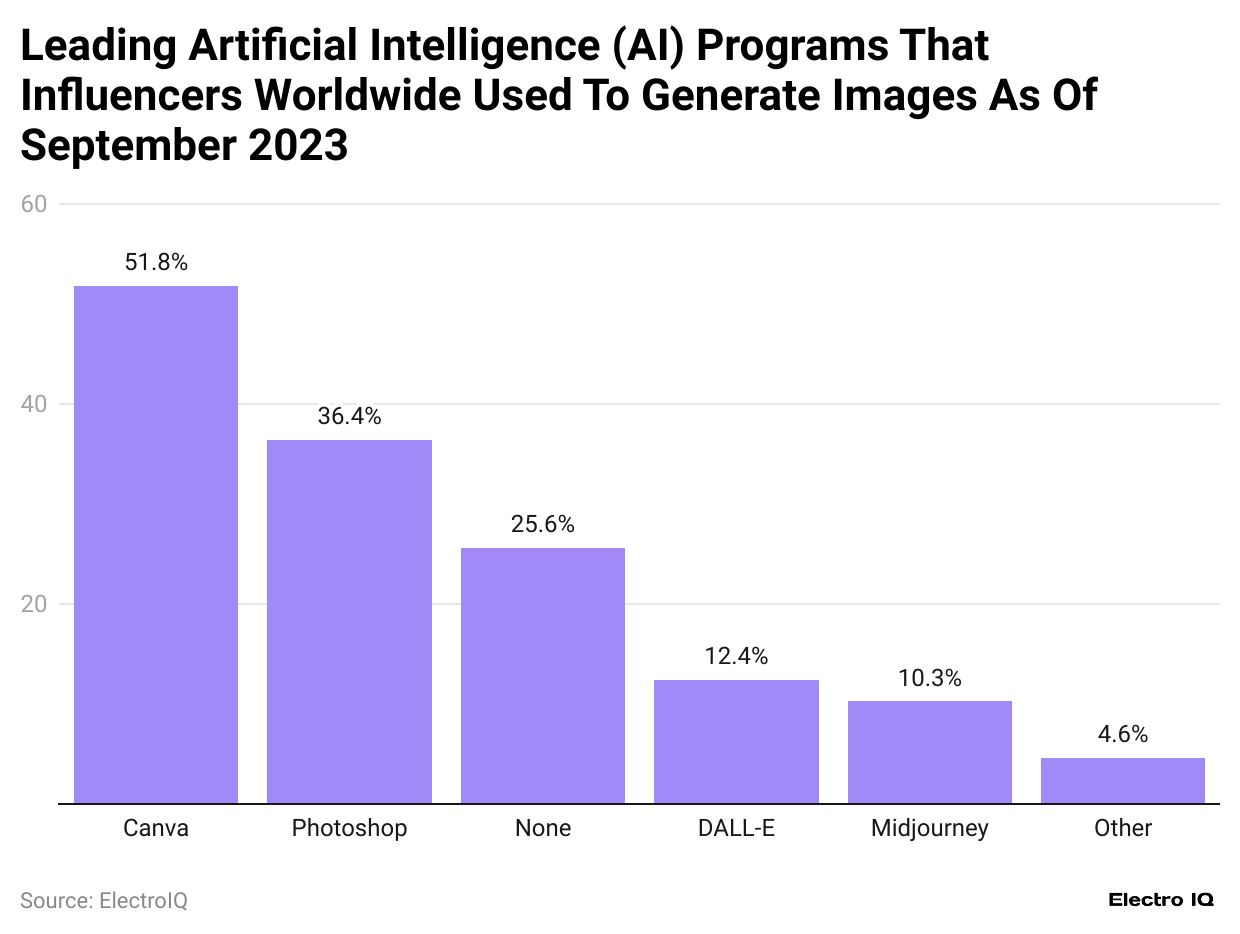
(Reference: wethrift.com)
- Canva is not solely a professional designer’s tool- it is used across various domains such as education, non-profit, entertainment, and even large corporations.
- More than nine out of ten Fortune 500 companies across the globe have a basic dependence on Canva for all their design requirements.
- According to the Canva statistics survey held in September 2023, the most used AI tool for image creation was Canva, with over 51% of influencers using it; it was followed by Photoshop, used by 36.4%.
- Canva has also enjoyed a significant increase in the entertainment sector’s adoption of the tool, with a 20% increment in just a year.
- Meanwhile, the number of nonprofits using their plans and tools has more than doubled. In 2023, over 500,000 non-profit organizations were using Canva, with over 800,000 individuals in these organizations designing for their causes.
- The platform has been rapidly growing in schools as well. Since 2020, Canva for Education has grown by 700%, with over 60 million teachers and students using it in 2023.
- The growth is particularly strong in countries such as the US, Brazil, and Mexico, where over 600,000 schools across 3,500 school districts now use Canva for Education.
- In 2024, the global number of educators and students using Canva crossed the 70 million mark, marking it an essential tool for learning and creativity.
Canva User Demographics
| Age Group | Canva Users Share |
|---|---|
| 18 to 24 years | 21.77% |
| 25 to 34 years | 31% |
| 35 to 44 years | 20.22% |
| 45 to 54 years | 13.32% |
| 55 to 64 years | 8.56% |
| More than 65 years | 5.13% |
(Source:demandsage.com)
Individuals from diverse age groups are users of the Canva platform, with the age group of 25 to 34 years being the largest group, comprising approximately 31% of all users. Next, the 18-24 age group of young adults comes in as the second-largest, with 21.77% of users. The next age group is 35-44 years, which represents 20.22% of Canva users, followed by 45-to-54-year-olds, accounting for 13.32%. Those in the 55-64 age group make up a minority at 8.56%, while the 65-plus age group is counted as the smallest size with 5.13% of all users. This shows that Canva is popular with younger adults but is also used by some older generations.
Canva Teams Statistics
- In May 2024, Canva launched Canva Enterprise, a subscription model meant to allow large organizations to use it.
- By the end of 2024, Canva was adopted by 95% of the Fortune 500 companies, up from 90% at the beginning of the year and demonstrating a remarkable surge of 138% since 2015, when only 40% of these companies were using it.
- There are reports of cutting production time by 90%, speeding up project turnaround times by 90%, design cost savings of 50%, and a 30% reduction in workload for external design work.
- In the year 2021, more than 500,000 teams across the globe were reported to have some sort of use for Canva, which translates to a 271% increase in comparison to the year 2015, which registered only 35,000 teams.
- Canva Statistics reveal that by the year 2024, over 130,000, that is, 26% of the enterprises, had at least 1,000 employees on Canva Teams.
- To analyze the impact of Canva for Teams in 2023, a Forrester Consulting study commissioned by Canva examined a representative business headquartered in North America with US$5 billion in annual revenue, 15,000 employees, and 250 users of Canva Teams.
- The report indicated a positive impact of 26% on employee productivity and US$1.7 million in total benefits in a comparative analysis with costs of US$309,000, with a net present value of US$1.4 million and an impressive 438% return on investment.
- Canva statistics estimated the enhancement of employee efficiency as worth US$816,000, avoided hiring as a cost saving of US$435,000, and agency cost reduction of US$412,100.
- The first year provided Canva for Teams with 6,500 hours saved, the second year with 7,645, while the guest team in the third year saved up to 8,216 hours, showing how Canva for Teams had streamlined design processes for large businesses.
Canva Design statistics
- Canva statistics state that in 2024, over 30 billion designs were created on Canva at an average rate of 38.5 million new designs daily.
- This constituted a growth of the preceding year by 50% from 20 billion designs. Over the decade from 2014 to 2024, designs skyrocketed by the astonishingly high figure of 16,665%, or 166 times, for an average of 16.5 billion designs created each year.
- The US was a major contributor to the development, contributing 3.8 billion designs, or 13% of all submissions in 2024 from the US.
- As of May 2024, 1.85 billion presentations on Canva represented a staggering 310,404% increase from 596,000 presentations created in 2015.
- A lot has changed in the design creation of Canva since its early days. Back in 2015, users produced about 6,593 designs per person to upload 1 million posts; by 2024, this saw astonishing growth as Canva was used to design 1.2 billion videos, 190 billion whiteboards, 375 million documents, and 89 million websites.
- By December 2024, Canva offered more than 800,000 templates, plus a library of over 100 million photos, videos, sounds, fonts, stickers, and illustrations.
- The platform added to its global reach throughout the year with more than 700,000 templates in languages other than English, which include 537,000 custom templates and 2.3 million localized design elements.
- In 2023, together with Warner Music and Merlin, Canva launched an incredible addition of over 500,000 popular music tracks on its platform to inspire the creativity of users worldwide.
Conclusion
Canva statistics highlight its continuing endeavor toward democratization of design for and empowerment of users across the globe. Given the ever-increasing base of users present in Canva, strengthening financial growth, strategic acquisitions, and seamless integration of AI technologies, Canva is poised to continue with an unrelenting pace on the path of innovation and market leadership in the design space.
FAQ.
The company is assessed to have a share of 10.26% within an estimated market of about US$15.4 billion for creative software. Whereas, Adobe way tops this with about 70%.
Canva has 185 million monthly users in 190 countries, having grown 3,700 times since its launch in 2013.
The year 2024 has seen an estimated US$2.7 billion in revenue from Canva in the continued growth narrative from a mere US$4.4 million in 2016.
The Education sector, with 23% utilisation of Canvas presentation users, comes next to Marketing (20%) Digital Marketing (15%) and then Social Media (14%).
Canva’s mobile app achieved more than 500 million app downloads, with the top three markets being India, Indonesia, and Brazil. It was the top photo editing app downloaded in the U.S. in November 2024, with 1.16 million downloads.

Barry Elad is a tech enthusiast who loves diving deep into various technology topics. He gathers important statistics and facts to help others understand the tech world better. With a keen interest in software, Barry writes about its benefits and how it can improve our daily lives. In his spare time, he enjoys experimenting with healthy recipes, practicing yoga, meditating, or taking nature walks with his child. Barry’s goal is to make complex tech information easy and accessible for everyone.




